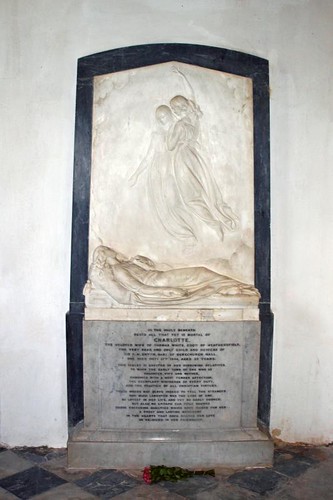During the late 1400s and early 1500s the church had been rebuilt in slender Tudor bricks. This building may have replaced a 14th-century church as it reused a fine doorway of this period in the tower and also some late-14th-century windows, although it is thought that these may have been brought here from St John’s Abbey, Colchester. The abbey owned the church and estate until its dissolution in 1536, when Henry VIII granted Berechurch to Thomas, Lord Audley, his Lord Chancellor. Around this time the Audley Chapel was added to the north of the chancel as a memorial chapel for family members and their descendants who, presumably, are buried beneath it.
The chapel appears to have received some alteration in the 17th century when it was extended northwards, maybe to accommodate the tomb of Sir Henry Audley, and again in 1872, when the church underwent a thorough restoration by Mr W Shead of Berechurch to the designs of Mr Charles Pertwee of Chelmsford.
The 1872 restoration involved an almost total rebuilding of the body of the church, but not the tower, nor the Audley Chapel. A report at the time stated that, ‘Here the care shown to the remains of the old fabric is strikingly exemplified. The ponderous weight of the monument to Sir Henry Audley had forced the north wall considerably out of perpendicular and the old roof, worn by successive ages, had become too tender to be tampered with and so the chapel has been, as it were, encased in a new building, with the old roof about six inches (15.2cm) under the new one'. In fact, the restorers seem to have concentrated mostly on encasing the north wall, as original brickwork may be seen in much of the east and west walls.
Because St Michael’s was so far from where most of its population lived, it was declared redundant in 1975. The Audley Chapel, because of its great interest and beauty, was vested in 1981 in what is now The Churches Conservation Trust, for people to visit and enjoy. As such it remains a holy place, consecrated for prayer and worship. The main body of the church (which is not open to the public) now has a new lease of life as offices.
ST MICHAEL AND ALL ANGELS. A brick church of c. 1500. W tower with diagonal buttresses with stone dressings; battlements. E window of three lights dated C17 by the Royal Commission. E window of the N chapel of three lights, depressed pointed with intersected tracery. The N chapel is the only interesting part of the church, on account of its hammerbeam roof, with decorated purlins and wind-braces, the C17 shields applied to the hammerbeam, and the C17 MONUMENT against the N wall. To Sir Henry Audley and wife, erected 1648. Stiffly semi-reclining, in armour; kneeling figures below. Big reredos background with inscription and segmental pediment. Black and white marble. - Sir Robert Smyth d. 1802, large, with urn in relief. - Mrs Charlotte White d. 1845. By J. Edwards, 1848. She lies on a couch, with two angels hovering near her. - DOOR. Early C16, of linenfold and other panels.
BERECHURCH HALL. Broad and towering Neo-Elizabethan mansion quite
asymmetrical, with plenty of French motifs mixed in. By Lee, 1882.
BERECHURCH. It has what it still calls a maypole green (without the maypole) to remind it of the gaieties of days gone by, traces of a Roman road recalling days when merchants came this way to Colchester, and a FIne church made new at the end of the 15th century. Its tower has a 14th century doorway and, still swinging in it, a door made up of linenfold and traceried panels by a Tudor craftsman. The font is 16th century. The magnificent hammerbeam roof of the Audley Chapel is richly carved with heads and flowers, with the arms of the Audleys below the wall-posts. The chapel was established in the days of Thomas Audley, who founded the family fortunes. He was town clerk of Colchester and rose to be Henry the Eighth’s Lord Chancellor and to preside at the trial of Sir Thomas More. He took Berechurch Hall from St John’s Priory at Colchester when the King and Thomas Cromwell broke up the monasteries. There is a splendid monument of Civil War days with Sir Henry Audley lying in armour in black and white marble, his five children kneeling.
Flickr.
Simon K.
One of the exceptions is Berechurch although its former parish church
of St Michael is redundant and converted into offices.
Simon K.
Colchester's southern suburbs are mostly interesting and attractive,
many of them former Roman settlements with wharves onto the Colne.
This was one of the wealthiest parts of England in the late middle
ages, and buildings of note survive. It would be true to say that,
with one or two exceptions, the suburbs are more interesting than
their churches.
18th century red brick tower, the church rebuilt in entirety in the
1880s after the earthquake except, importantly, for the 15th century
Audley Chapel on the north side of the chancel. Berechurch is a large
suburb separated from the town centre by the Garrison, but this church
was out in the fields. Declared redundant in 1975, it was furiously
wrecked by vandals in 1981, after which the Diocese obtained a
demolition order.
It was saved at the eleventh hour by the Borough Council working with
the then Redundant Churches Fund. The RCF (now CCT) took on the
Audley Chapel, the Borough oversaw the restoration of the body of the
church and its splitting into two levels for offices, currently
architects downstairs and solicitors upstairs, where you get the key
to the chapel.
This is crammed with Audley memorials, some very good, but it doesn't
feel much like a church. Good 15th Century roof. An unlikely survival.
Ironically, dull suburbia has now encroached to reach the churchyard.



No comments:
Post a Comment